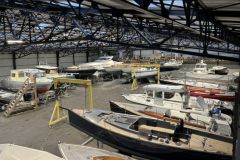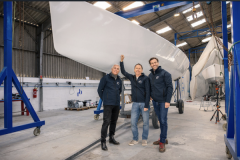A reinforced partition
Matt had already started to laminate his future mainsheet bulkhead independently. But in view of the significant forces it would receive, he decided to seek the advice of an engineer. Statically upwind, in 30 knots of wind, with the mainsail up, the force applied by the sheet is estimated at about 2.75 tons. But dynamic effects must also be taken into account, as in an involuntary gybe, nicely illustrated in the video. For Duracell, a factor of 4 is chosen. As a result, the bulkhead will have to withstand 11 tons of pull.
The reinforcements are recalculated and on the top of the bulkhead, which will receive the mainsail track, no less than 18 layers of bi-axial fiberglass will cover the metal insert. In addition, there are unidirectional fabrics at the head of the bulkhead and vertically to distribute the forces to the foot of the bulkhead.
Matt does the layering in several stages, with the help of friends. He then cuts the wall according to the template.
A fully enclosed roof
It's time to position the bulkhead on the boat. After cutting the top of the roof, the rear bulkhead fits perfectly. The window openings are cut out and the cockpit cover is installed. However, Matt doesn't laminate the whole thing together, so that he can move the bulkhead to easily get equipment on board.
After 8 months of work, summarized in the 2nd video at the bottom of the article, the roof finally has its final form.









